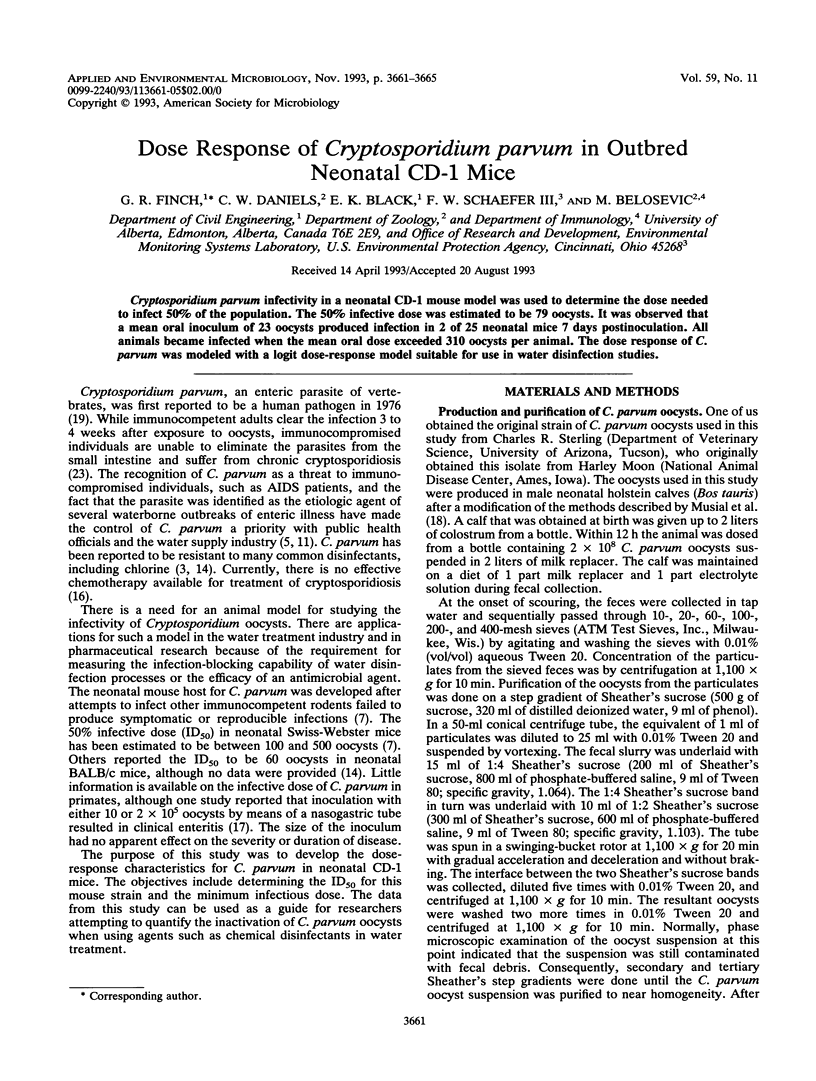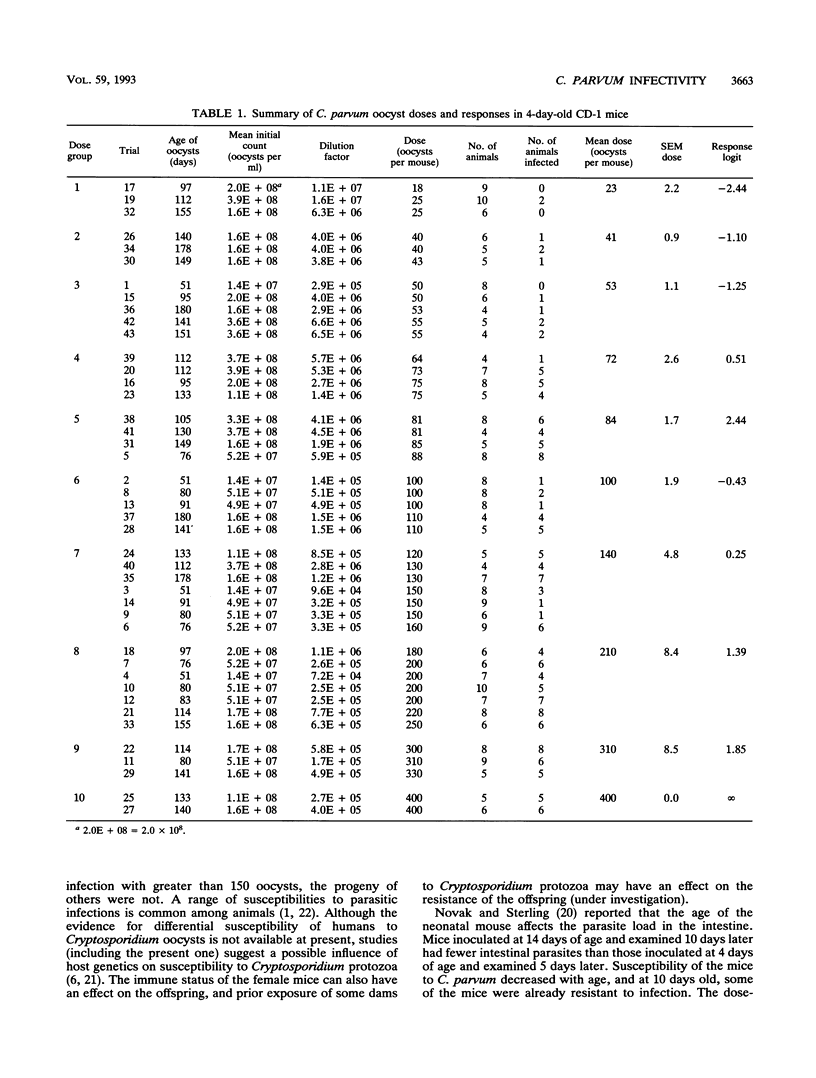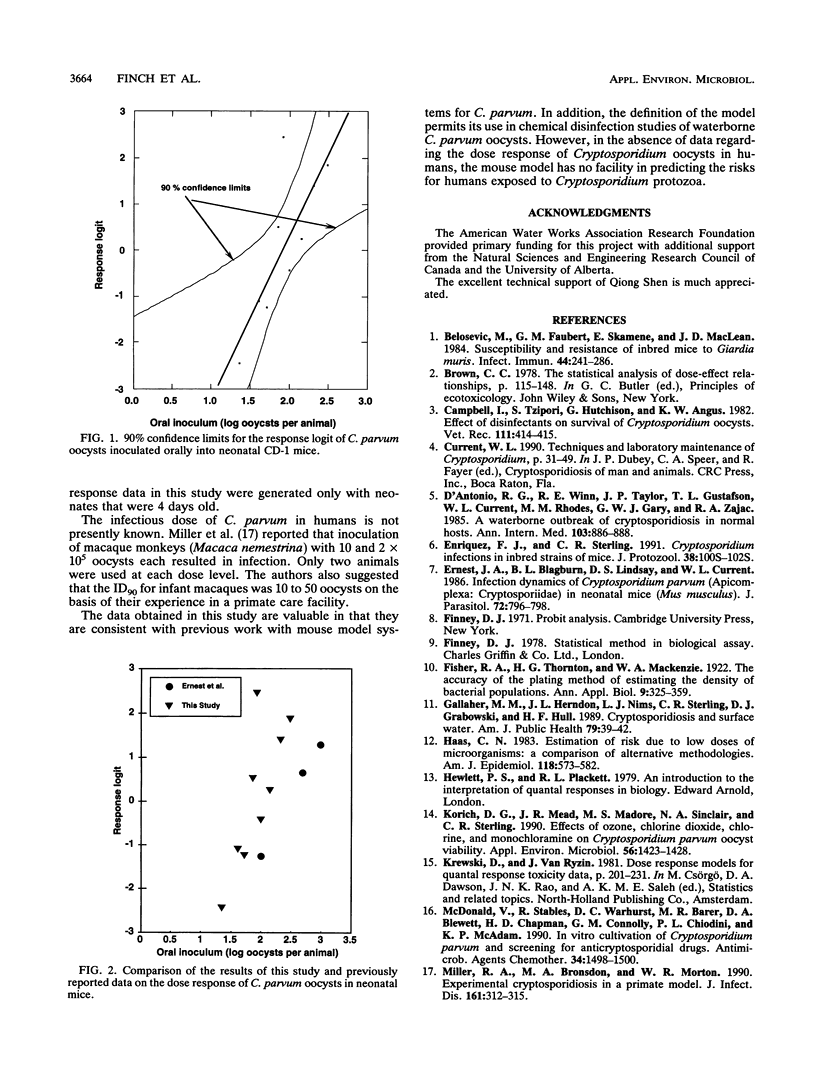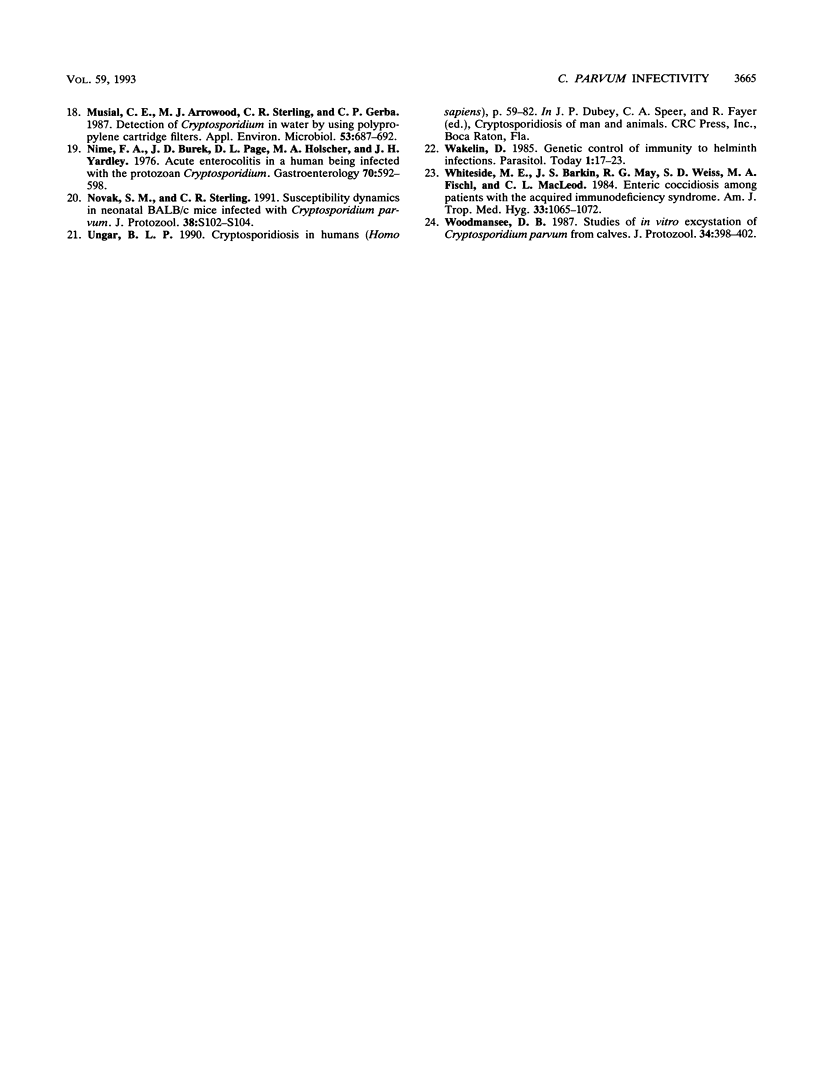Abstract
Cryptosporidium parvum infectivity in a neonatal CD-1 mouse model was used to determine the dose needed to infect 50% of the population. The 50% infective dose was estimated to be 79 oocysts. It was observed that a mean oral inoculum of 23 oocysts produced infection in 2 of 25 neonatal mice 7 days postinoculation. All animals became infected when the mean oral dose exceeded 310 oocysts per animal. The dose response of C. parvum was modeled with a logit dose-response model suitable for use in water disinfection studies.
Full text
PDF




Selected References
These references are in PubMed. This may not be the complete list of references from this article.
- Belosevic M., Faubert G. M., Skamene E., MacLean J. D. Susceptibility and resistance of inbred mice to Giardia muris. Infect Immun. 1984 May;44(2):282–286. doi: 10.1128/iai.44.2.282-286.1984. [DOI] [PMC free article] [PubMed] [Google Scholar]
- Campbell I., Tzipori A. S., Hutchison G., Angus K. W. Effect of disinfectants on survival of cryptosporidium oocysts. Vet Rec. 1982 Oct 30;111(18):414–415. doi: 10.1136/vr.111.18.414. [DOI] [PubMed] [Google Scholar]
- D'Antonio R. G., Winn R. E., Taylor J. P., Gustafson T. L., Current W. L., Rhodes M. M., Gary G. W., Jr, Zajac R. A. A waterborne outbreak of cryptosporidiosis in normal hosts. Ann Intern Med. 1985 Dec;103(6 ):886–888. doi: 10.7326/0003-4819-103-6-886. [DOI] [PubMed] [Google Scholar]
- Enriquez F. J., Sterling C. R. Cryptosporidium infections in inbred strains of mice. J Protozool. 1991 Nov-Dec;38(6):100S–102S. [PubMed] [Google Scholar]
- Ernest J. A., Blagburn B. L., Lindsay D. S., Current W. L. Infection dynamics of Cryptosporidium parvum (Apicomplexa: Cryptosporiidae) in neonatal mice (Mus musculus). J Parasitol. 1986 Oct;72(5):796–798. [PubMed] [Google Scholar]
- Gallaher M. M., Herndon J. L., Nims L. J., Sterling C. R., Grabowski D. J., Hull H. F. Cryptosporidiosis and surface water. Am J Public Health. 1989 Jan;79(1):39–42. doi: 10.2105/ajph.79.1.39. [DOI] [PMC free article] [PubMed] [Google Scholar]
- Haas C. N. Estimation of risk due to low doses of microorganisms: a comparison of alternative methodologies. Am J Epidemiol. 1983 Oct;118(4):573–582. doi: 10.1093/oxfordjournals.aje.a113662. [DOI] [PubMed] [Google Scholar]
- Korich D. G., Mead J. R., Madore M. S., Sinclair N. A., Sterling C. R. Effects of ozone, chlorine dioxide, chlorine, and monochloramine on Cryptosporidium parvum oocyst viability. Appl Environ Microbiol. 1990 May;56(5):1423–1428. doi: 10.1128/aem.56.5.1423-1428.1990. [DOI] [PMC free article] [PubMed] [Google Scholar]
- McDonald V., Stables R., Warhurst D. C., Barer M. R., Blewett D. A., Chapman H. D., Connolly G. M., Chiodini P. L., McAdam K. P. In vitro cultivation of Cryptosporidium parvum and screening for anticryptosporidial drugs. Antimicrob Agents Chemother. 1990 Aug;34(8):1498–1500. doi: 10.1128/aac.34.8.1498. [DOI] [PMC free article] [PubMed] [Google Scholar]
- Miller R. A., Bronsdon M. A., Morton W. R. Experimental cryptosporidiosis in a primate model. J Infect Dis. 1990 Feb;161(2):312–315. doi: 10.1093/infdis/161.2.312. [DOI] [PubMed] [Google Scholar]
- Musial C. E., Arrowood M. J., Sterling C. R., Gerba C. P. Detection of Cryptosporidium in water by using polypropylene cartridge filters. Appl Environ Microbiol. 1987 Apr;53(4):687–692. doi: 10.1128/aem.53.4.687-692.1987. [DOI] [PMC free article] [PubMed] [Google Scholar]
- Nime F. A., Burek J. D., Page D. L., Holscher M. A., Yardley J. H. Acute enterocolitis in a human being infected with the protozoan Cryptosporidium. Gastroenterology. 1976 Apr;70(4):592–598. [PubMed] [Google Scholar]
- Wakelin D. Genetic control of immunity to helminth infections. Parasitol Today. 1985 Jul;1(1):17–23. doi: 10.1016/0169-4758(85)90101-2. [DOI] [PubMed] [Google Scholar]
- Whiteside M. E., Barkin J. S., May R. G., Weiss S. D., Fischl M. A., MacLeod C. L. Enteric coccidiosis among patients with the acquired immunodeficiency syndrome. Am J Trop Med Hyg. 1984 Nov;33(6):1065–1072. doi: 10.4269/ajtmh.1984.33.1065. [DOI] [PubMed] [Google Scholar]
- Woodmansee D. B. Studies of in vitro excystation of Cryptosporidium parvum from calves. J Protozool. 1987 Nov;34(4):398–402. doi: 10.1111/j.1550-7408.1987.tb03199.x. [DOI] [PubMed] [Google Scholar]


